Max Bruch’s Violin Concerto No. 1
Max Bruch’s Violin Concerto No. 1
Bruch wrote three violin concerti. Why are the other two never performed, when everything of his that I do hear is wonderful: surely these cannot languish because they are rubbish? Two other concerti for violin and orchestra Bruch himself regarded as at least as fine as the famous first. It is very wonder.
Like its usual partner-on-record, Mendelssohn's concerto, Bruch's G Minor is a mould-breaker, yet its formal novelty is camouflaged by exceptional lyrical and dramatic qualities, a disguise reinforced by the rhapsodic nature of much of its material. Even submerged, though, formal processes lend strength, and this work is stronger than it might seem.
Max Bruch’s Violin Concerto No. 1
Many hold that the opening is merely an extended introduction to the slow movement. Quite frankly, this view fails to resist even my limited analytical gaze: the first movement possesses a form and character all its own. It may be overshadowed by the Adagio's exquisite song and the Finale's propulsive energy, but it is tense, expectant, and fervent - arguably the most gripping music in the entire concerto.
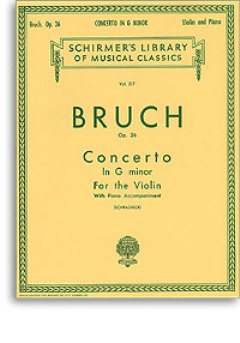
Concerto No.1. First Edition
Movement I: Prelude: Allegro moderato
The romantic concerto was all about the soloist being a star, much like today’s film stars. The composer would write difficult technical passages to display the soloist’s virtuosic skill. This concerto has 4 short cadenzas written by Bruch (two at the opening and two at the end). This was unusual and broke away from the traditional form of having one cadenza at the end of the movement, which is often improvised.
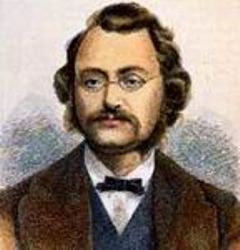
Max Bruch
Allegro moderato is an elaborated ternary form (ABA). The outer sections are characterised by passionate declamation, with some especially gritty expostulations from the soloist. The central section introduces a strong melodic line, harbinger of the Adagio. A dotted figure in the orchestra eventually dominates a remarkable bridge passage of immense dramatic drive. The opening materials return, clearing the air for . . .
Movement II: Adagio
The slow second movement is often adored for its powerful melody, and is generally considered to be the heart of the concerto. The rich, expansive themes, presented by the violin, are underscored by a constantly moving orchestra part, keeping the movement alive and helping it flow from one part to the next.
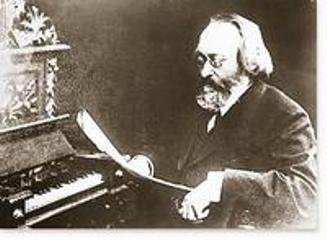
Max Bruch
There is a rondo form, the ABACABA pattern discernable through a veil of continuous variation. [A] is the famed ecstatic melody for the soloist. [B] appears on the horns, three descending pairs of notes (Strauss subsequently cloned this in his Alpine Symphony). Gently pulsing tympani highlight the return of [A]. [C], more agitated, initiates the movement's climax at which [A] ardently propels [B] into the limelight. [B] yields to the violin, caressing [A] and weaving upwards, making room below for [B] to quietly snuggle in.
Movement III: Finale: Allegro energio The third movement, or Finale as it is often called, is usually exciting and fun in character. There is a calling motif played in the strings that is then heard in the clarinets and oboes. Bruch uses a technique called double stopping – more than one note played on the solo violin at the same time. Some of the melodies are evocative of Hungarian folk melodies; people say this may have been a gesture of warmth to the Hungarian violinist Joseph Joachim to whom the concerto is dedicated.
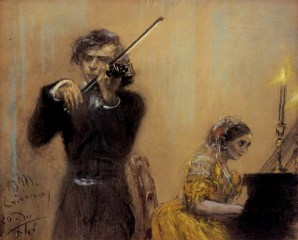
Clara Schumann & Joseph Joachim by Adolf Menzel
The concerto was first completed in 1866 and the first performance was given on 24 April 1866 by Otto von Königslow with Bruch himself conducting. The concerto was then considerably revised with help from celebrated violinist Joseph Joachim and completed in its present form in 1867. The première of the revised concerto was given by Joachim in Bremen on 5 January 1868 with Karl Martin Rheinthaler conducting.
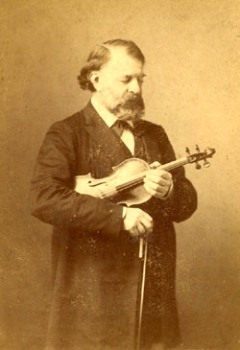
Joseph Joachim
Max Bruch's Violin Concerto No. 1 in G minor, Op. 26, is one of the most popular violin concertos in the repertoire. It continues to be performed and recorded by many violinists and is arguably Bruch's most famous composition.
Last Updated (Tuesday, 17 March 2015 16:31)








